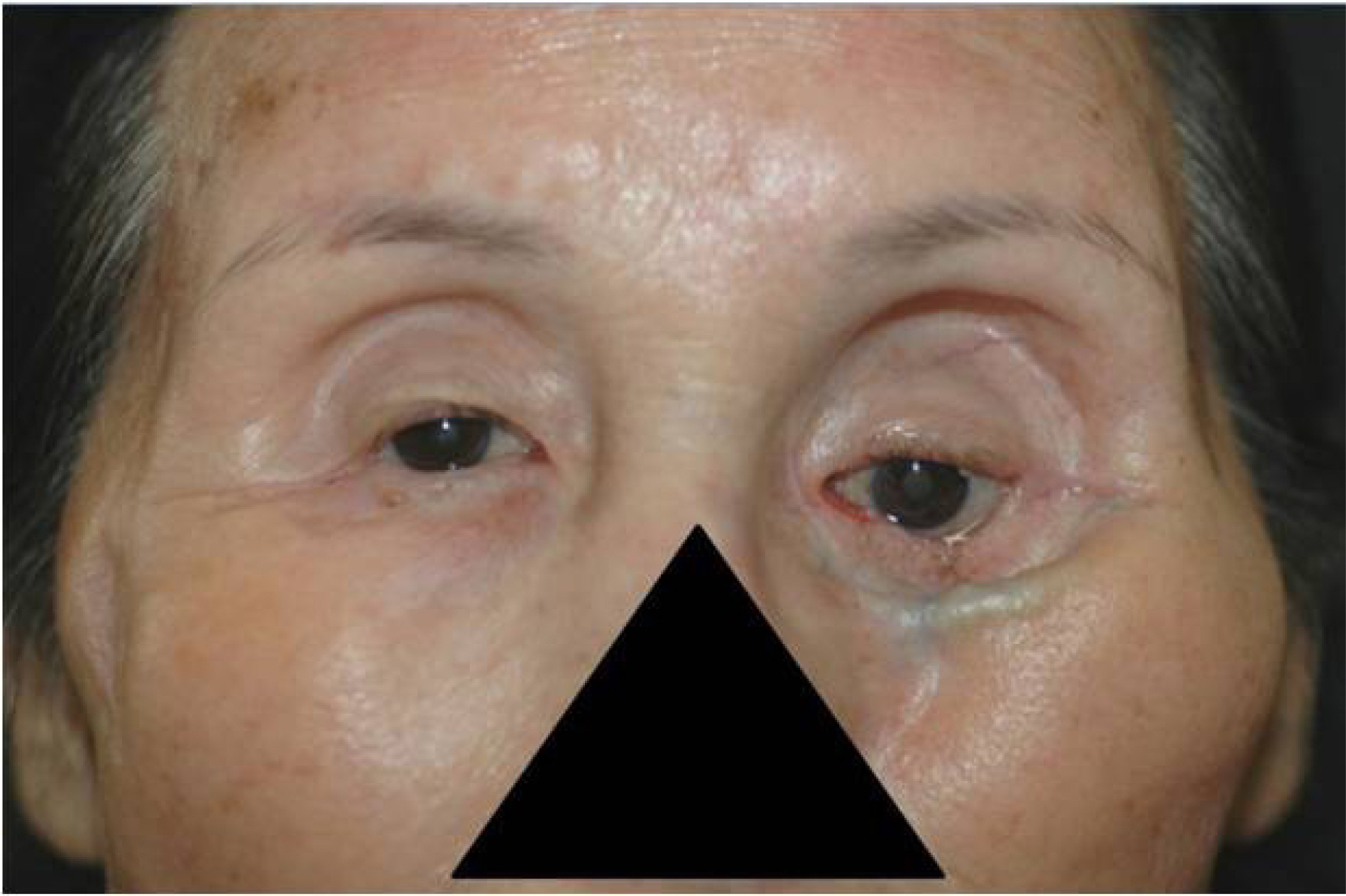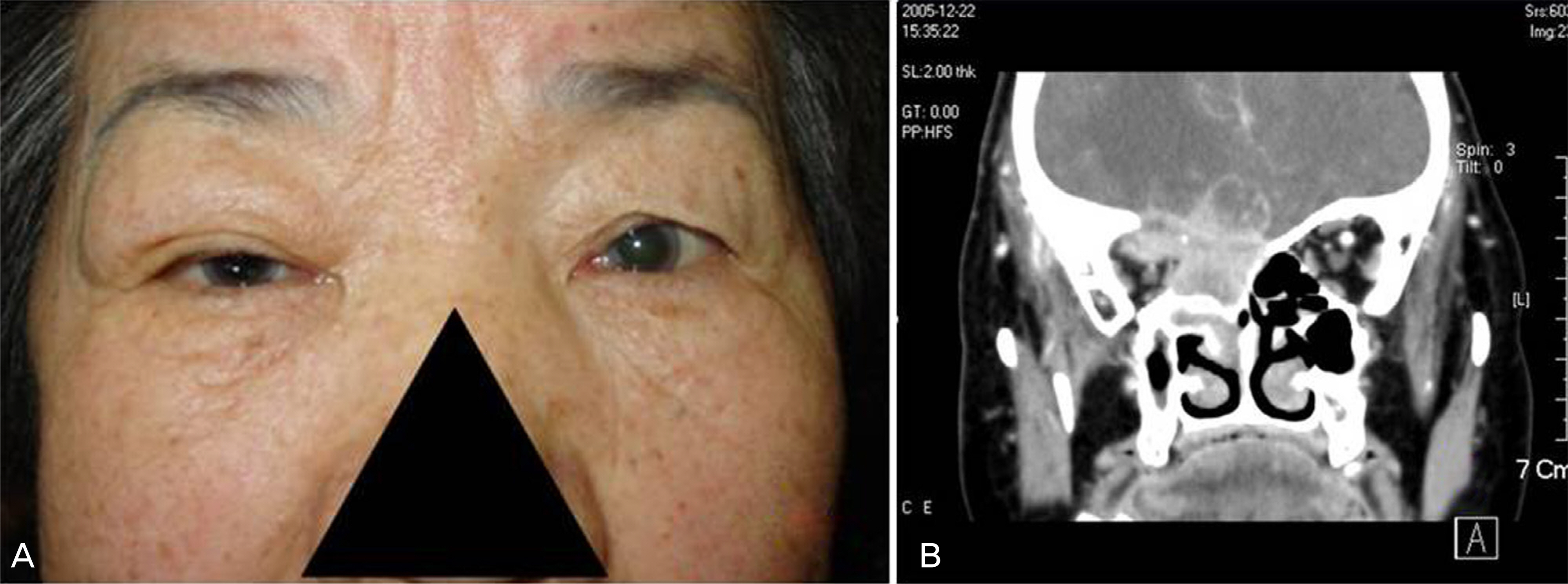J Korean Ophthalmol Soc.
2009 Oct;50(10):1455-1460. 10.3341/jkos.2009.50.10.1455.
Ocular Manifestations of Paranasal Sinus Malignancies
- Affiliations
-
- 1Department of Ophthalmology, Guri Hospital, Hanyang University Colleag of Medicine, Guri, Korea. lyjot@hanyang.ac.kr
- 2Department of Otolaryngology, Guri Hospital, Hanyang University Colleag of Medicine, Guri, Korea.
- KMID: 2212760
- DOI: http://doi.org/10.3341/jkos.2009.50.10.1455
Abstract
- PURPOSE
To investigate ocular complications that occur after orbital preservation surgery for paranasal malignancies and to identify the early clinical features of ophthalmic manifestations in paranasal malignancy patients. METHODS: We reviewed the clinical charts of patients following ophthalmic consultation after orbital preservation surgery for paranasal malignancies. We also investigated the early clinical features of ophthalmic manifestations in patients with paranasal malignancies.
RESULTS
In our study, 54 patients had paranasal malignancies. Among them, 41 had undergone orbital preservation surgery, and 19 patients sought an ophthalmology consultation. There were seven patients who presented with eye symptoms caused by paranasal malignancies before the diagnosis. Paranasal malignancies included squamouscell carcinoma (13 cases), adenocarcinoma (3 cases), plasmocytoma (1 case), malignant schwannoma (1 case), and undifferentiated carcinoma (1 case). The locations of the origin of the tumor included the maxillary sinus (16 cases) and the ethmoid sinus (3 cases). The most common eye symptoms after orbital preservation surgery were enophthalmos, lid retraction, tearing, strabismus, inflammation, dry eyes, and cataracts, in order of frequency. Patients who visited the ophthalmic clinic due to paranasal malignancies had eye symptoms such as proptosis, nonspecific ocular pain, strabismus, tearing, eyelid swelling, and relative afferent pupillary defects, in order of frequency.
CONCLUSIONS
Ocular complications were more common if the paranasal malignancy had invaded the orbital bone. However, many of the patients with disease invasion of the periosteum had no nasal or ocular symptoms upon presentation. Therefore, these patients should be managed carefully since symptoms may initially be vague and nonspecific.
MeSH Terms
Figure
Cited by 1 articles
-
A Case of Paranasal Diffuse Large B-Cell Lymphoma with the Orbital Invasion Masquerading as Chronic Sinusitis
Young Ji Lee, Ji He Lim, Helen Lew
J Korean Ophthalmol Soc. 2011;52(11):1351-1356. doi: 10.3341/jkos.2011.52.11.1351.
Reference
-
References
1. Myers LL, Nussenbaum B, Bradford CR, et al. Paranasal Sinus Malignancies: An 18-Year Single Institution Experience. Laryngo-scope. 2002; 112:1964–9.
Article2. Suarez C, Ferlito A, Lund VJ, et al. Management of the orbit in malignant sinonasal tumors: Wiley Periodicals, Inc. Head Neck. 2008; 30:242–50.3. Imola MJ, Schramm VL. Orbital Preservation in Surgical Management of Sinonasal Malignancy. Laryngoscope. 2002; 112:1357–65.
Article4. Smith B, Lisman RD, Baker D. Eyelid and orbital treatment following radical maxillectomy. Ophthalmology. 1984; 91:218–28.
Article5. Gluckman JL. Tumors of nose and paranasal sinuses. Donald PJ, Gluckman JL, Rice DH, editors. The Sinuses. 1st ed. New York: Raven Press;1995. 1:chap. 25.6. Triana RJ, Uglesic V, Virag M, et al. Microvascular Free Flap Reconstructive Options in Patient with Partial and Total Maxillectomy Defects . Arch Facial Plast Surg. 2000; 2:91–101.7. Goldberg RA, Joshi AR, McCann JD, Shorr N. Management of severe cicatricial entropion using shared mucosal grafts. Arch Ophthalmol. 1999; 117:1255–60.
Article8. Takeda A, Shigematsu N, Suzuki S, et al. Late Retinal comp-lacations of radiation therapy for nasal and paranasal malignancies Relationship between irradiated-dose area and severity. Int J Radiat Oncol Biol Phys. 1999; 44:599–605.9. Carrau RL, Segas J, Nuss DW, et al. Squamous cell carcinoma of the sinonasal tract invading the orbit. Laryngoscope. 1999; 109:230–5.
Article10. Daniel MA. Metastatic and Secondary Orbital Tumors. John JW, Peter AR, George BB, editors. Principles and Practice of Ophthalmology. 3rd ed.Philadelphia: Saunders Elsevier;2008. 3:chap. 239.11. Kim JS, Jang SO, Lim HH, et al. Paranasal sinus tumor. No HJ, editor. Head and Neck surgery II. Seoul: Iljogac;2002. 2:chap. 22.
- Full Text Links
- Actions
-
Cited
- CITED
-
- Close
- Share
- Similar articles
-
- A Cases of Osteoma of The Ethmoid Sinus Presenting Exophthalmos
- A Huge Osteoma Originated From the Frontal Sinus: Case Report
- Development of Paranasal Sinus Mucocele Following Endoscopic Sinus Surgery
- MR findings of paranasal sinus mucocele report of 3 cases
- Endoscopic Surgery for Paranasal Sinus Mucocele




